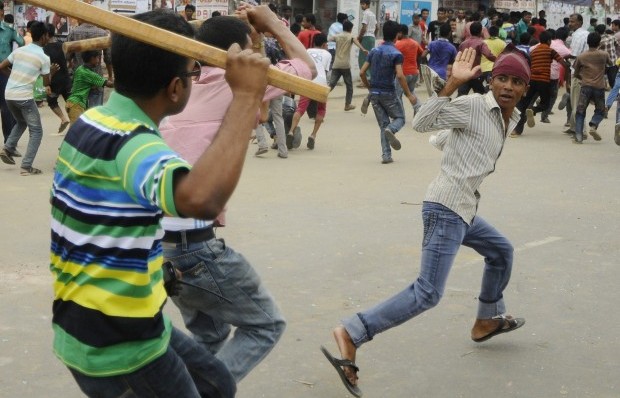
Plain-clothed Bangladeshi police brandish sticks as they attempt to break up demonstrating garment workers following the collapse of an eight-storey building, in Dhaka on April 26, 2013. (AFP PHOTO/STR)
Dhaka, Reuters—Bangladesh textile workers vented their anger on Friday, burning cars and clashing with police, as the death toll passed 300 following the collapse of a building housing factories that made low-cost garments for Western brands.
Miraculously rescuers were still pulling people alive from the rubble – 72 since daybreak following 41 found in the same room overnight – two days after the eight-storey building collapsed on the outskirts of the capital, Dhaka.
But there were fears that hundreds of people were still trapped in the wreckage of the building, which officials said had been built illegally without the correct building permits.
“Some people are still alive under the rubble and we are hoping to rescue them,” said deputy fire services director Mizanur Rahman.
A spokesman for Prime Minister Sheikh Hasina said she had ordered the arrest of the owners of the building and of the five factories that occupied it.
Army spokesman Shahinur Islam said the death toll had reached 304 and H. T. Imam, an adviser to the prime minister, said it could exceed 350.
Anger over the working conditions of Bangladesh’s 3.6 million garment workers, the overwhelming majority of them women, has grown steadily since the disaster, with thousands taking to the streets to protest on Friday.
About 2,350 people have been rescued, at least half of them injured, from the remains of the building in the commercial suburb of Savar, about 30 km (20 miles) from Dhaka.
An industry official has said 3,122 people, most of them female garment workers, had been in the Rana Plaza building despite warnings that it was structurally unsafe.
Emdadul Islam, chief engineer of state run Capital Development Authority (CDA), said that the owner of the building had not received the proper building consent, obtaining a permit for a five-storey building from the local municipality, which did not have the authority to grant it.
“Only CDA can give such approval,” he said. “We are trying to get the original design from the municipality, but since the concerned official is in hiding we cannot get it readily.”
Furthermore, another three storeys had been added illegally, he said. “Savar is not an industrial zone, and for that no factory can be housed in Rana Plaza,” Islam told Reuters.
Bangladesh is the second-largest exporter of garments in the world but many factories remained closed for a second day on Friday, with garment workers protesting against poor conditions and demanding the owners of the building and the factories it housed face harsh punishment.
Police and witnesses said protesters set fire to a number of vehicles and damaged other garment factories.
Dhaka District police chief Habibur Rahman identified the owner of the Rana Plaza building as Mohammed Sohel Rana, a leader of the ruling Awami League’s youth front.
Imam, the prime minister’s adviser, said Rana had “vanished into thin air”.
“People are asking for his head, which is quite natural. This time we are not going to spare anybody,” Imam said.
Wednesday’s collapse was the third major industrial incident in five months in Bangladesh. In November, a fire at the Tazreen Fashion factory on the outskirts of Dhaka killed 112 people.
“This incident is devastating for us as we haven’t recovered from the shock of Tazreen fire yet,” said Finance Minister Abul Maal Abdul Muhith, who visited the site on Friday.
Such incidents have raised serious questions about worker safety and low wages in Bangladesh and could taint the poor South Asian country’s reputation as a producer of low-cost products and services.
North American and European chains, including British retailer Primark and Canada’s Loblaw, said they were supplied by factories in the Rana Plaza building.
Mohammad Atiqul Islam, president of the Bangladesh Garment Manufacturers and Exporters Association (BGMEA), said the proprietors of the five factories inside the building had ignored the association’s warning not to open on Wednesday after cracks had been seen in the building the day before.
“We asked not to open the factories and told them we will send our engineer, and until you get the green signal don’t open the factories,” Islam told Reuters.
“But, unfortunately, they violated our instructions,” he said. A bank in the building did close on Wednesday after the warning.
Savar residents and rescuers dropped bottled water and food on Thursday night to people who called out from between floors. Nearby, relatives identified their dead among dozens of corpses wrapped in cloth on the veranda of a school.
Special prayers were offered for the dead, injured and missing at mosques, temples and pagodas across Bangladesh on Friday.
Ten labor groups called for a strike on Sunday by workers at garment factories across the country.
Sixty percent of Bangladesh’s garment exports go to Europe. The United States takes 23 percent and Canada takes 5 percent.
Primark and Loblaw, as well as PWT, a Danish company whose Texman brand clothes were also made in factories at Rana Plaza, operate under codes of conduct aimed at ensuring products are made in good working conditions.
The largest factory, New Wave Style, which listed many European and North American retailers as its customers, occupied the sixth and seventh floors, documents seen by Reuters showed.
